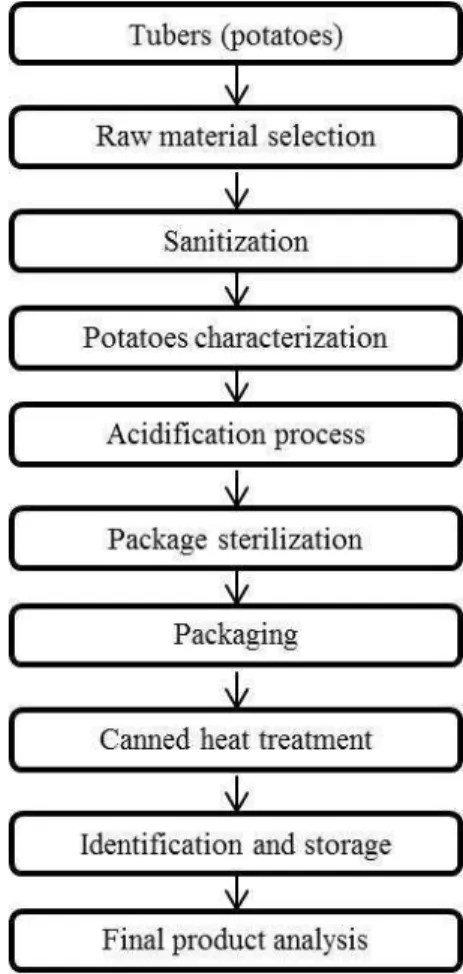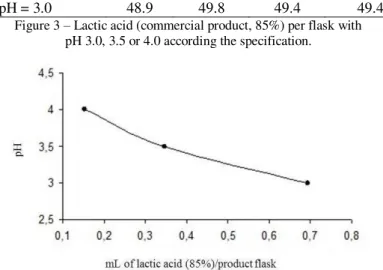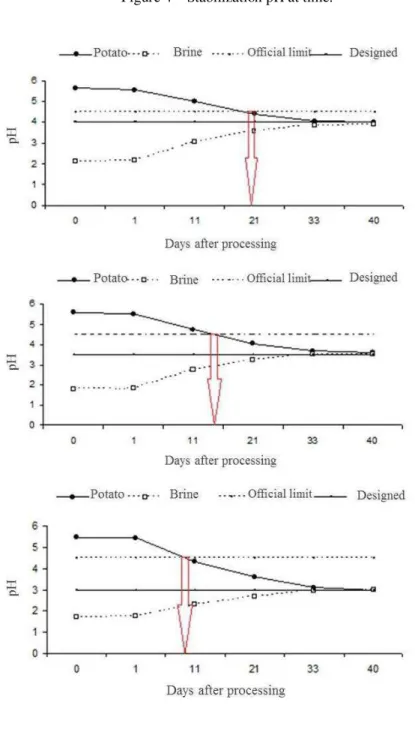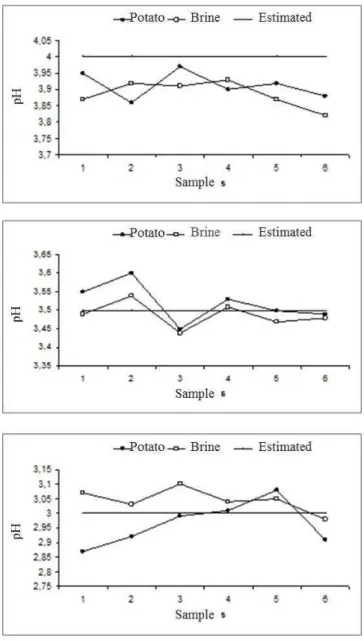SMALL CANNED POTATOES (SOLANUM TUBEROSUM) CONSERVED IN
LACTIC ACID
CONSERVA DE BATATAS (SOLANUM TUBEROSUM) DE PEQUENO
PORTE EM ÁCIDO LÁTICO
Bruno José Malinski Larangeira Vianna1; Isabelli Vieira dos Santos2; Ernesto Quast3; Leda Battestin Quast4; Dorivaldo da Silva Raupp5
1,2
Universidade Estadual de Ponta Grossa – Ponta Grossa – Brasil
3,4,5
Departamento de Engenharia de Alimentos, Setor de Ciências Agrárias e de Tecnologia, Universidade Estadual de Ponta Grossa – Ponta Grossa – Brasil raupp@uepg.br
Resumo
A batata (Solanum tuberosum) é uma importante fonte de alimento contribuindo para a alimentação em nível mundial bem como para a estabilização social do meio rural nos países em desenvolvimento. A pesquisa teve por objetivo geral produzir conservas de batatas de pequeno porte (calibre V) com segurança alimentar, agregando valor a uma matéria-prima de importância inexpressiva para o mercado como in natura. Foram avaliados três diferentes processos (pH 4,0; 3,5; 3,0), utilizando o ácido lático e uma salmoura contendo 4% de sal. Os valores médios para a massa, comprimento e largura dos tubérculos foram respectivamente 15,4 g, 35,2 mm e 27,2 mm. O pH da batata in natura foi 5,34 e a acidez total titulável, em ácido lático, foi igual a 1,186 g kg-1 de batata crua. Todas as conservas estabilizaram abaixo de pH 4,0, enquadrando-se nas normas oficiais, que tem por limite pH 4,5. A conserva atingiu o equilíbrio em 34 até 40 dias após o processamento. A batata teve uma aparência agradável dentro da embalagem, demonstrando um potencial para ser comercializada como conserva e, assim, contribuir para aumentar a renda principalmente dos pequenos produtores da agricultura familiar.
Palavras-chave: produto; desenvolvimento; segurança. 1 Introduction
The potato (Solanum tuberosum) known in Brazil as England potatoes, are in fact originated from Andean region in South America were it has been cultivated for the past 7,000 years. The potato was only introduced in Europe in the sixteenth century. Potato is a tuber vegetable belonging to the Solanaceae family, same as tomato, eggplant and peppers (LANA et al., 2000). The Solanum genus contains over 2,000 species, although only about 150 produce tubers. Potatoes grown in Brazil belong to the Solanum tuberosum (LOPES, 2011).
Tubers are stems adapted for food supply and breeding. They are formed as a result of the thickening of the stolons, which are modified stems, underground, root-like (LOPES, 2011).
Universidade Tecnológica Federal do Paraná - UTFPR Campus Ponta Grossa - Paraná - Brasil ISSN: 1981-3686 / v. 07, n. 01: p 876-885, 2013
D.O.I: 10.3895/S1981-36862013000100001
Revista Brasileira de Tecnologia
Agroindustrial
877 Potato is the fourth largest culture of importance in the world, after rice, wheat and corn. Its transport is limited to short distances due to their high perishability. It is one of the main food being grown in over 125 countries and consumed by more than on billion people, contributing to food social stabilization in the developing countries.
The tubers can be classified according to their diameters (class). Tubers over 70mm longitudinal diameter present high industrial yield and are classified as Class “I”; tubers between 70 and 42 mm, as Class “II”; tubers between 42 and 33 mm, as Class “III”; tubers between 33 and 28 mm, as Class “IV” and tubers with less than 28 mm in diameter are classified as Class “V” (CEAGESP, 1999. Adaptation).
Potato is a source of high quality protein, vitamins and minerals. Starch is the main caloric nutrient. In nutritional terms, 100 g of potato supplies about 10% of recommended protein needs for child, or 10% of thiamine, niacin, B6 vitamin, folic acid and 50% C vitamin for an adult (GODOY et al., 2003).
Canned foods are an alternative for food preservation and storage that can be produced during the harvest time, were there is high demand and low prices, to ensure product supply during the off-season. Technologies applied for the preservation of food products have the following objectives (EMATER, 2000): reduce waste crops, preserve the products of the season and have them available in off-season periods, improve family nutrition, alternative source for rural family by the commercialization of these products.
The preservation of food with quality and safety, is based on: quality of raw material, use of appropriate technology and proper handling. According to the Resolution n. 352 of 2000-December 23 (BRAZIL, 2002), preserved vegetable is the product prepared from tubers, roots, rhizomes, bulbs, stems, buds, leaves, flowers, petioles, fruits and cultivated mushrooms whose edible parts are filled raw, pre-cooked or rehydrated, immersed or not in appropriate liquid, subjected to technological processing before or after sealed hermetically to prevent its alteration.
Some vegetables are very sensible to heat treatment and loose their acceptance if submitted to a sterilization process (required for food with pH above 4.5), because of changes on its textural properties. Typical examples are hearts of palm, artichoke, onion and cucumber. The technology used to control this problem consists in the addition of an edible acid (usually organic acids) to the salt solution used to fill the product, ensuring a pH value of 4.5 or less. Using this procedure, it is possible to apply a gentle heat treatment, without risk of botulism neurotoxin (BoNT) formation. (PASCHOALINO, 1994; RAUPP et al., 2008). In addition, acidification followed by pasteurization may be carried out without the use of boilers and autoclaves with less need for investment and viability of small scale product.
878 In canned products, the acidification a critical control point that must be controlled to ensure food safety, without significant taste alterations (PASCHOALINO, 1994). During acidification, two basic factors must be taken into consideration: The amount of acid should be added to the brine for safe final equilibrium pH and under 4.5. The equilibrium pH is measured in homogeneous mixture of acidified brine with vegetable, after a storage time which depends on the diffusivity of acid in to the vegetable; the diffusion of acid into the vegetable can be particularly influenced by the size of the vegetables. For hearth palm, depending on the length and diameter of the product, the pH equilibrium can reach at until 30 days of storage. Large food particles can provide development of BoNT in preserves with equilibrium pH under 4.5 (QUAST et al., 2010).
Especially for food, the term sterilized means commercial sterile, because, in fact, food did not reach the temperature that would make the food completely sterile (POTTER e HOTCKISS, 1995). According to the authors, commercially sterile refers to a heat treatment that inactivates all pathogens and spoilage organisms that can grow under normal storage conditions. Commercially sterile foods may contain a small number of bacterial spores resistant to heat, that do not multiply in food at favorable temperatures due its acidity. Canned food and are commercially sterile, with a shelf life of at least two years, depending on its nutritional content. The objective of this work consisted of adding value to small potatoes designed as Class “V” with the development of an acidified canned potato secure for direct human consumption.
2 Material and methods
The experiments to develop the product using Monalisa variety consisted of three processes (treatments) with variation on the addition of acid. Lactic acid was used as acidification agent in at 4% brine. Figure 1 shows the process steps for the production of canned potatoes.
The experiments were conducted using the good practices recommended for food production. The tubers (potatoes) were purchased from Municipal Market of Curitiba – PR. Potatoes were stored in a cardboard box at room temperature (±25 °C), selected and washed with water and soap and then remained for fifteen minutes in an aqueous solution containing sodium hypochlorite at a concentration of 3.75 mL L-1 for sanitation. After this process, potatoes were washed with potable water and put in a plastic box at room temperature.
A sample of 150 potatoes was used to characterize its size (width, length and mass). Potatoes pH and titrable acidity (TTA) was measured in triplicate using aleatory three tubers with total mass of 18 g. The tubers were ground separately and the titration was carried out using sodium hydroxide 0,01 M according to AOAC (2006).
Lactic acid is an organic acid that can be used in the food industry. To know the amount of lactic acid to be added to brine, titration procedure was applied using 0.5% acid lactic solution in a
879 potato mixture (55.82 g of potato plus brine). The amount of lactic acid used for titration was recorded when pH titration reached 4.0;3.5 and 3.0. The mass of lactic acid to be added in brine was calculated taking into consideration the maximum mass of potato and minimum volume of brine inside one standard size and format glass of product.
Figure 1 – Flow chart of the canned potatoes process
Glasses with 268 mL capacity were used as the product package. Metal lids with rubber sealing ring inside were used. The glass and the lids were washed with water and soap and then pasteurized using boiling water for 20 minutes. This procedure prevents product contamination from the packaging. Then, glass and lids were placed in appropriate place until package process. The processes resulted in 72 glasses with product, 24 for each treatment (pH 4.0; 3.5 or 3.0). All treatments were identifying.
The potatoes were put inside the glasses after weighing. Acidified brine containing 4% salt was added completely to fill the glass and allow a space for exhaust air inside the container during pasteurization.
Products were subjected to heat treatment in boiling water for 50 minutes and the glasses remained submersed in water during this period. After heat treatment the flasks with product were slowly using water until room temperature.
880 The canned products were identify and kept at room temperature until analysis. The pH in the middle of the potato was evaluated at time 0; 11; 21; 33; 40 and 163 days after processing.
During storage, up to 40 days after processing, the measurement of pH on the potato was done using three different potatoes taken from 1 randomly flask. For this analysis, 5 g of potato (located in its central) was mixed and homogenized with 50 mL of distilled water. The pH values were measured introducing the bulb in the mixture. To measure the pH of the brine, the bulb was introduced in the canning liquid after potatoes removal.
At 163 days after processing, the pH values for potatoes and brine were made using six randomly flasks. In this case, the pH value for potatoes was measured considering a total mass of three potatoes.
3 Results and discussion
Potatoes used to produce acidified canned were identified as Class V according CEAGESP classification (CEAGESP, 1999), since almost of potatoes were smaller than 28 mm. The average length, width and mass of 150 potatoes were respectively 35.2 mm, 27.2 mm and 15.44 g. The average pH of three fresh potatoes was 5.34. Total titrable acidity (TTA) of fresh potatoes was 1.186 g kg-1 expressed as lactic acid. Figure 2 shows the appearance of the final product.
Figure 2 – Final product: canned potato
Sampling of 25 flasks were used to determine the average mass of potato, brine and potato plus brine. The values were respectively 133.38 g, 142.59 g and 275.96 g. Taking into consideration the titration results showed in Table 1 and mass of potato and brine, it was possible to determine the amount of lactic acid (Figure 3) to be added to canned potato for each specific pH values of 4.0, 3.5 or 3.0 presented in Table 1.
Table 1 – Volume of lactic acid (0.5%) required to achieve pH of 4.0, 3.5 or 3.0 in three samples of potatoes plus brine.
Samples 1 2 3 Media
Potato (g) 53.83 50.44 63.21 55.82 Brine (g) 57.53 53.9 67.77 59.73 Process Volume of lactic acid 0.5% (mL) pH = 4.0 10.2 11.5 10.9 10.9 pH = 3.5 23.9 24.8 25 24.6
881 pH = 3.0 48.9 49.8 49.4 49.4
Figure 3 – Lactic acid (commercial product, 85%) per flask with pH 3.0, 3.5 or 4.0 according the specification.
The amount of brine solution used was estimated taking into consideration the glass capacity and are presented in Table 2.
Table 2 – Quantities of lactic acid, salt and water used to prepare brine solutions to fill 24 flask of each pH.
Process
(pH) Commercial lactic acid - 85% (mL) Salt (g) Water (g) [Lactic acid in brine (%)]
4.0 4.61 172 4123.39 0.09
3.5 12.9 172 4115.91 0.206
3.0 20.94 172 4103.63 0.414
If the filling process is made without control, there may be variation in the proportion of potato and brine content in glasses. If potatoes are put more than the average medium (133.3 g), the glass will receive less brine and consequently receive less lactic acid. This result in a high pH value than the desired and in this case, there is chance of the development of Clostridium botulinum. However, if there is a glass with less potatoes than desired, the glass will receive a larger amount of brine and the potatoes will have a pH values lower than the desired.
The results of acidity stabilization measured as pH values of potato and brine for 163 after process are shown in Figure 4.
After 34 to 40 days after processing, all samples reached pH stabilization. The interior of potato products with equilibrium pH of 4.0 took 21 days reach the pH value under 4.5. Products with equilibrium pH of 3.0 took 11 days for the same conditions, while products with final pH of 3.5 needed times between 11 and 21 days for the pH value under 4.5 in the interior of the product. After a post processing between 34 and 40 days, the canning of the three treatments show a pH stabilization.
882 Figure 4 – Stabilization pH at time.
The pH data obtained at 163 days after processing are shown in Figure 5. It can be observed that pH values were stabilized for each treatment.
The results of pH shown in Figure 5 confirm that the products were obtained according to the standards of good manufacturing practices applied to acidified food. Considering the results of pH stabilization, their use is recommended only after 40 days of process, because before this period the acid did not penetrate the product.
Comparing the data from this study with the results of processing of acidified stem palm (Bactris gasipaes) (Gomes et al., 2006), can be inferred that both processes still sow pH variation in brine and product. However, in canned potatoes, this variation was smaller than the stem palm.
883 Same results occur when compared to the work of Bellegard (2005) for acidified leaf palm. The canned potatoes in this work showed a lower variation in pH when compared to these authors.
Figure 5 – pH values of 6 glasses after stabilization. For designed pH 4.0, the real value was 3.91±0.04; For designed pH 3.5, the real value was 3.52±0.05; For designed pH 3.0, the real value was 3.02±0.08.
Regarding food security, it is not recommended to work with pH designed very close to the official limit, in Brazil, 4.5. In the researches in heart of palm (BELLEGARD et al., 2005; GOMES et al., 2006) it was found that even working at pH of 4.3, below the official limit, they observed pH fluctuations and some canned exceed the official limit.
The results of the current research were satisfactory in the aspect f food security. The procedures applied to produce canned potatoes safe for human consumption with pH lower than the official limit of pH 4.5. Based on the results of this work, canned with small potatoes are an alternative to prevent waste of raw material and a possibility to improve diversification of product and commercialization to the farms.
884 4 Conclusions
The potatoes used on this work were classified in Class V and almost smaller than 28 mm. The average sizes of potatoes were length of 32 mm and mass of 15.44 g.
The process were satisfactory regarding to food security for canned products with pH stabilization under 4.5
For designed pH 4.0 the pH stabilized after 21days of process, for pH 3.5, the stabilization time occurred between 11 and 15 days after processing and for pH 3, the stabilization time occurred between 5 and 11 days after processing.
The canned 'Monalisa' potato had a nice visual appearance and can be an alternative destination for small tubers without economic value. The small family farms can take the advantage of this technology to add value to their production and diversifying and increasing their income.
Abstract
Potato (Solanum tuberosum) is an important food source contributing to the social stability in rural areas in developing countries. This research aims the study of secure canned potatoes production using small potatoes with no significant importance to market due its size. Three final products were evaluated: (pH 4.0, 3.5, 3.0) by adding acid lactic and salt solution at 4% (w/w). Potatoes used in this study presented medium values of 15.4 g, 35.2 mm and 27.2 mm for mass, length and width respectively. Fresh potatoes pH was 5.34 and titratable acidity, (expressed in lactic acid) was 1.186 g kg-1 of raw potato. All canned potatoes stabilized below the limit of pH 4.5 established by Brazilian Regulation for low acid products. The canned potatoes reached pH equilibrium in 34 to 40 days after processing. The conserve presented good appearance, demonstrating potential to be safely produced and consumed in small scale and thus help to increase own from small family farmers.
Key-words: product; development; safety. References
AOAC. Official methods as analysis of the association of official analytical chemists. Association of Official Analytical Chemists, Inc., Arlington, 2006.
BELLEGARD, G.; RAUPP, D. S.; CHAMSOHN, F. P.; BORSATO, A. V. Avaliação de procedimentos de acidificação de conservas de palmito foliar de pupunha (Bactris gasipaes). Acta Scientiarum. Agronomy, v. 27, n. 2, p. 247-254, abr./jun. 2005.
BRASIL. Agência Nacional de Vigilância Sanitária. Resolução n o352, de 23 de dezembro de 2002. Regulamento técnico de boas práticas de fabricação para estabelecimentos produtores/industrializadores de frutas e ou hortaliças em conserva, disponível em: <http://e legis.anvisa.gov.br/leisref/public/showAct.php?id=12327&word=> Acesso em 01 jun. 2011.
BRIMELOW, C.; VADEHRA, D. Refrigeración. In: ARTHEY, D.; DENNIS, C. (Eds). Procesado de hortalizas. Zaragoza, Espanha: Acribia, 1992. p.139-173.
885 CEAGESP. Companhia de Entrepostos e Armazéns Gerais de São Paulo. Classificação da batata in natura. São Paulo: CEAGESP, novembro, 1999. (folder), disponível em <http://www.ceagesp.gov.br/produtor/classific/fc_batata>. Acesso em 01 jun. 2011.
CEAGESP-Companhia de Entrepostos e Armazéns Gerais de São Paulo. Batata., disponível em <http://www.ceagesp.gov.br/produtos/produtos/batata>. Acesso em 22 fev. 2011.
EMATER-Paraná. Transformação artesanal de hortaliças em conservas, picles e molhos por Alice Casagrande, Margarida Maria B. Weiss e Nina Rosa Szymanski. 2 ed. Curitiba: Emater, 2000. 32p.
FRANCO, B. D. G. M.; LANGRAF, M. Microrganismos patogênicos de importância em alimentos. In: FRANCO, B. D. G. M.; LANDGRAF, M. (Eds). Microbiologia dos alimentos. São Paulo: Atheneu, 1996. p.33-41.
GODOY, R. C. B.; SCOTTI, C. A.; BUENO, L. A. P. A Batata no Estado do Paraná. In: PEREIRA, A.S.; DANIELS, J. O cultivo da batata na Região Sul do País. 1ed. Brasília: Embrapa, 2003. p.23-25.
GOMES, M.; VALLE, J.; RAUPP, D. S.; CHAIMSOHN, F. P.; BORSATO, A. V. Processamento de Conservas de palmito caulinar de pupunha contendo diferentes graus de acidez. Ciência e Agrotecnologia, v. 30, n. 3, p. 569-574, mai./jun. 2006.
LANA, M. M.; LUENGO, R. F. A; MATOS, M. J. L. F.; TAVARES, S. A; MELO, M. F.; SANTOS, F. F. 2000.
Hortaliças: como comprar, conservar e consumir, disponível em
<http://www.cnph.embrapa.br/laborato/pos_colheita/dicas/>. Acesso em 23 fev. 2011.
LOPES, C. A. Batata – Botânica. 2011, disponível em: <http://www.batatas.com.br/cultivo/botanica.asp>. Acesso em 10 mar. 2011.
PASCHOALINO, J. E. Processamento de hortaliças. Campinas: Manual Técnico do Instituto de Tecnologia de Alimentos – ITAL, 1994. v.4, p.1-70.
PASCHOALINO, J. E. Hortaliças acidificadas em conserva: riscos e cuidados. Informativo Fruthotec do Instituto de Tecnologia de Alimentos – ITAL, v. 3, n. 2, p. 1-3, 1997.
POTTER, N. N.; HOTCHIKISS, J. H. Food science. 5. ed. New York: Chapman & Hall, 1995. 608p.
QUAST, E.; RUIZ, N. L.; SCHMIDT, F. L.; VITALI, A. A. Cinética de acidificação de palmito de pupunha (Bactris
gasipaes Kunth.). Brazilian Journal of Food Technology, v. 13, p. 286-292, 2010.
http://dx.doi.org/10.4260/BJFT2010130400038
RAUPP, D. S. Higiene e sanidade do produto palmito. Documentos – Embrapa Florestas, Colombo-PR, v. 105, p. 59-66, 2004.
RAUPP D. S.; GARDINGO J. R.; MORENO L. R.; HOFFMAN J. P. M.; MATIELLO, R. R.; BORSATO A. V. Minimilho em conserva: avaliação de híbridos, Acta Amazônica, Manaus, v. 38, n. 3, p. 509-516, 2008. http://dx.doi.org/10.1590/S0044-59672008000300016




